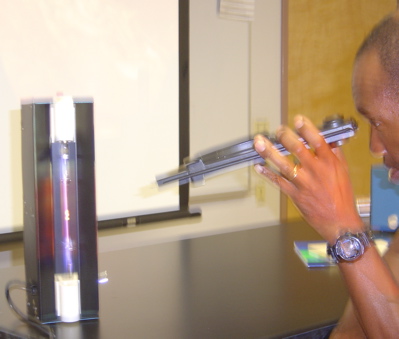Stellar Spectral Analysis
Author(s): Aldo-Rafael Cos and Thomas Schuster
SED 695B; Fall 2005
Principles illustrated:
Electron configuration, wavelengths, spectral lines, excited electrons.

Standards addressed:
Middle School: 4b.Students know that the Sun is one of many stars in the Milky Way galaxy and that stars may differ in size, temperature, and color.
High School: 4f.
Students know how to identify the characteristic properties of waves:
interference (beats), diffraction, refraction, Doppler effect, and polarization.
Students oftentimes may question how scientists determine
the composition of our sun and other stars. By using the principle of
spectral analysis, it is possible for students to explore in a laboratory
setting how various elements are identified in stars.
Electrically charged or superheated elements emit colors, which can be
broken down into their constituent frequencies by a prism or a measuring
device called a spectroscope. Using this procedure, astronomers can determine
the elemental composition of distant objects like stars.
Procedure:
1. After gathering required
materials, ensure that everything is in working order.
2. Set up tube exciter in front of the room and plug it in.
3. Select a gas tube and place in the exciter. Turn it on.
4. Cover windows with something dark and turn off the lights.
5. Have students observe and record spectral lines using their spectroscopes.
6. Students record lines using colored pencils approximating the spaces
between the lines.
7. Turn off exciter and exchange tubes repeating the procedure for as
many gas tubes as you would like the students to explore.
8. Have students answer questions, engage in discussions, and draw conclusions.
References & Links:
Encyclopedia Britannica Online: http://www.britannica.com/eb/article-52822
NASA Supernova Chemistry: http://imagine.gsfc.nasa.gov/docs/teachers/lessons/supernova/supernova_chemistry.html